Types of low flow fixtures:
There are two types of low flow fixtures. The most popular type is the aerating models while the alternative is the non-aerating models. An aerating model will mix air and water to ensure that the flow of water is constant. A non-aerating model pulses the water stream in order to maintain the water temperature to deliver a strong spray.
There are various types of low flow plumbing fixtures. These include toilets, faucets, aerators, and showerheads. These fixtures are found to be more efficient than the average faucet. There are a number of technologies that are used in developing low flow fixtures. Toilets may be designed to have large drain passages, bowls and tanks which ensure that flushing is more efficient and easier. Gravity systems may be supplemented with water supply line pressure, vacuum pump or by using compressed air.
The benefit of a low flow fixture:
A normal faucet that is used will not be able to compensate for a change in water pressure in the inlet. Since water pressure cannot be controlled, users will tend to use more water whenever the water pressure runs high and less whenever there is a fall in water pressure. Using a water control aerator will help ensure constant water flow at the same rate, regardless of the water pressure. There are also aerators that will allow you to turn off the water at the aerator itself. This technology has also been incorporated into showerheads that allow you to control water at various settings.
When comparing normal faucets and showerheads to low flow faucets, you realize a normal showerhead uses 4 to 5 gallons per minute while a low flow showerhead cuts this down to a maximum of 1.6 gallons. A low flow faucet costs between $8 and $50. An average low flow toilet will use up to 1.6 gallons of water. This is much more economical when compared to a regular toilet that uses almost 3.5 gallons of water. Low flow aerators can reduce water usage from 4 gallons to 2 ½ gallons, which is an increase in efficiency by 40%.










